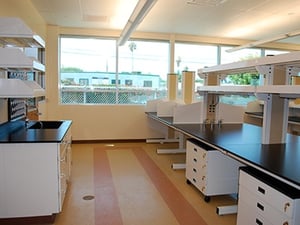As a lab manager, every decision you make, from the layout of your workspace to the furniture you choose, directly impacts the efficiency and effectiveness of your research.
In the dynamic world of modern science, where innovation is key and boundaries are constantly pushed, the design of your laboratory is more than just aesthetics … It's a strategy.
At some point, you may be forced to deal with concerns about whether you have a modern lab design that meets today’s needs. This concern could lead to questions like:
- How does my organization efficiently and cost effectively add new laboratory space?
- How can we perform multidisciplinary activities under one roof?
- Is it possible to refresh, modify or replace my existing facilities, furniture and equipment?
- How can I cost effectively adapt to my lab's changing needs?
Modular laboratory furniture offers a solution that can adapt to the evolving demands of your environments. By providing customizable and flexible lab furniture options, modular designs allow you to adjust to multiple space configurations and accommodate multidisciplinary activities under one roof with ease.
The cost-effective nature of modular furniture also makes any updates, modifications or replacements more affordable, ensuring that your laboratory remains at the forefront of innovation without breaking the bank.
Here’s why modular laboratories are emerging as an innovative solution and what important factors you should consider when choosing new laboratory furniture for your lab space.
Modular Laboratories: Innovative Solutions
For laboratory managers seeking answers to these burning questions, modular laboratory design has emerged as an innovative solution.
In recent years, modular laboratory units have grown in demand, particularly from government agencies and contractors that need flexible and quick solutions. Modular pieces are effective during emergency response because they can be packed up and shipped to any location on demand, as well as set up within hours.
 Modular laboratory furniture works by utilizing a system of interchangeable components that can be easily assembled, reconfigured or expanded to meet the specific needs of a laboratory environment. These components typically include work surfaces, storage units, shelving and equipment supports, among others.
Modular laboratory furniture works by utilizing a system of interchangeable components that can be easily assembled, reconfigured or expanded to meet the specific needs of a laboratory environment. These components typically include work surfaces, storage units, shelving and equipment supports, among others.
The key to modular furniture's functionality lies in its standardized dimensions and versatile design. This allows for seamless integration and compatibility across different furniture pieces, enabling lab managers to mix and match components as needed to create custom layouts tailored to their workflow and space requirements.
Modular furniture often incorporates features such as adjustable height settings, removable panels and quick-release mechanisms, further enhancing its adaptability and usability. This flexibility not only accommodates changes in equipment and research protocols but also facilitates efficient space utilization and ergonomic considerations for lab personnel.
Modular laboratory furniture can be an asset in a variety of environments, from academic research to industrial laboratories, healthcare facilities and government agencies. In the end, this versatile and scalable solution promotes efficiency, flexibility and innovation across various industries and applications.
Why Your Furniture Selection Is Important?
Your furniture selection directly impacts the functionality, efficiency and safety of your laboratory environment, influencing everything from workflow optimization to ergonomic considerations for personnel.
Here is why modular laboratory furniture may make sense for your lab space.
Ease of Use In The Lab
Ease and convenience are required for labs to run efficiently, and the flexibility offered by modular furniture solutions can accommodate each user’s individual needs.
Laboratories that offer flexible configurations allow technicians to work at their highest capacity without being hampered by poor ergonomic design. When it comes to your laboratory environment, it’s important to ensure that your technicians have easy, unimpeded access to their equipment and materials.
Rigid and poorly designed furniture can create many difficulties, particularly when users are attempting to perform experiments or laboratory testing. Having to constantly bend or reach out for materials that are not conveniently located in the workstation can slow down productivity and increase incidents of workplace injury.
Safety In The Lab
Laboratories by their very nature require well thought-out protocols to protect the safety of their workers. Modular laboratory furniture can not only create an easier and more convenient environment for its users, but can also help to improve safety in the lab. Here's how:
laboratory furniture can not only create an easier and more convenient environment for its users, but can also help to improve safety in the lab. Here's how:
- Freedom of movement: Layouts that promote a freedom of movement for lab workers can also minimize the risk of technicians bumping into one another while trying to maneuver around poorly designed furniture or equipment that does not work with the furniture layout.
- Hazardous situations avoided: Laboratories that are heavy users of hazardous chemicals can be volatile and dangerous places. Labs that are laid out effectively with movable furniture can prevent dangerous and hazardous situations.
- Easy movement in emergencies: Flexible lab arrangements can help make the area more prepared in the event of a disaster, as furniture will be able to move to minimize harmful outcomes.
- Ergonomic benefits: Modular laboratory furniture enhances safety standards by offering ergonomic benefits, allowing workers to adjust workstations to their preferences, reducing the risk of strain or injury during long hours of experimentation. You can read more about the benefits of ergonomic-friendly furniture in our article, How To Use Ergonomic Design To Foster Workplace Safety.
Furniture that is in a fixed position and inconveniently located is at risk of suffering significant damage and can be a major problem if there is a chemical spill or contamination.
By eliminating or greatly reducing these types of hazards with a flexible design and movable furniture, you can ensure the safety of your lab and its occupants.
Adaptability In The Lab
Modern laboratory technology continues to advance at a furious pace in the scientific community. By utilizing modular laboratory furniture, you can ensure that your lab can quickly adapt to advancements with new equipment, technology or methodologies.
In addition to equipment adaptability, modular furniture can also allow you to integrate essential connectivity infrastructure more easily. Incorporating features like data ports, online network access points and strategically-placed power outlets into the furniture design ensures that researchers have easy access to the digital tools and resources necessary for their work.
This streamlined connectivity not only enhances collaboration and communication within the lab but also promotes a highly productive and efficient work environment where data can be easily shared, analyzed and accessed in real-time.
By embracing modular laboratory furniture, your lab can stay ahead of the curve, adapting swiftly to technological advancements and research innovations while maximizing productivity, safety and collaboration among lab personnel.
How To Find A Modular Laboratory Furniture Partner
For organizations that are in the process of new construction or renovation of an existing laboratory space, one of the biggest challenges will be finding the right modular laboratory furniture manufacturers.
Because of the complexity of the laboratory environment and the sophisticated operations of lab technicians, it is important to move beyond price when comparing modular laboratory furniture options. Purchasing inferior cheaply manufactured equipment from shoddy manufacturers and distributors may cause more problems than any cost savings realized.
Price, product innovation, experience, engineering capacity and quick lead times are among the necessary attributes when looking for a capable partner in a modular laboratory furniture supplier.
Choose a partner that has specialized experience working with your type of laboratory environment that can provide guidance for improving workflow, electrical systems, load capacities and lab countertops for the specific chemicals in your lab.
Whether you're expanding your facilities, refreshing your workspace or simply adapting to changing needs, modular laboratory furniture is the strategic tool you need to unlock the full potential of your scientific endeavors.


